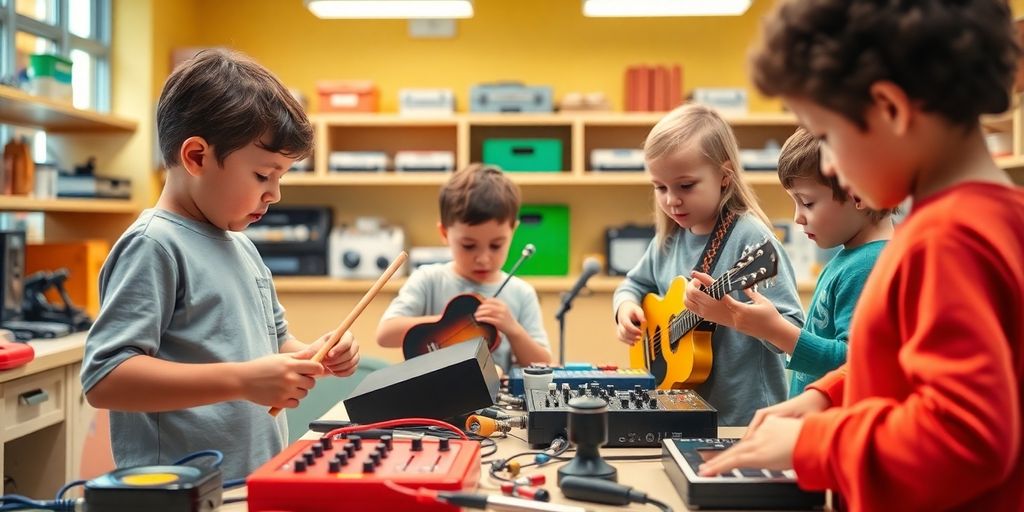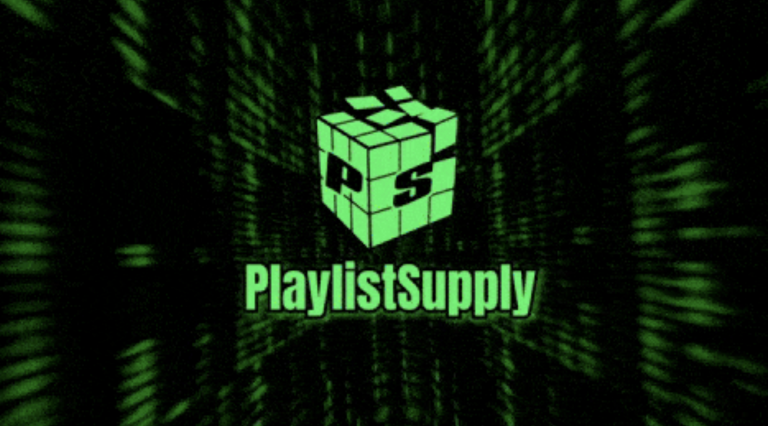
Ever wondered how music really works? Forget just listening; let’s get our hands dirty! This article is all about diving into a music laboratory, a place where science meets sound. We’ll explore how vibrations create tunes, how technology helps us make new sounds, and even how old-school physics explains the music we love. Get ready to experiment and discover the amazing world of music in a whole new way.
Key Takeaways
- Understand how physical vibrations form the basis of all music.
- Explore how digital tools and software can be used for music creation and composition.
- Learn about the scientific principles like frequency and harmonics that shape musical sounds.
- Discover how music composition involves storytelling and understanding music history.
- Engage with interactive music laboratory activities like sampling and sound design.
Exploring Sound Vibrations in the Music Laboratory
Ever wonder how a guitar string makes that sound, or why a drum hit feels like it’s buzzing in your hands? It all comes down to vibrations! In the music lab, we get to play with these invisible forces that create the music we love. It’s not just about listening; it’s about feeling and seeing how sound actually works.
The Science of Musical Vibrations
Sound is basically a wave, and waves are made by things moving back and forth really fast – that’s vibration. When you pluck a guitar string, it shakes. This shaking pushes the air around it, creating little waves of pressure that travel to your ears. Different materials vibrate differently, which is why a piano sounds nothing like a trumpet, even if they play the same note. We can see these vibrations using special tools, like a strobe light on a tuning fork, or even by sprinkling salt on a drumhead and hitting it. The salt dances to show where the vibrations are strongest.
Hands-On Sound Exploration
We’ve got all sorts of cool stuff to play with. Think about making your own instruments. You can stretch rubber bands over a box to make a guitar, or use different lengths of pipe to create a set of panpipes. The length and tightness of the rubber band, or the size of the pipe, changes how fast it vibrates, and that changes the sound. It’s a great way to learn about how pitch works. We also experiment with how sound travels. Did you know sound travels better through some things than others? We can test this by putting our ears to a table and tapping on the other end, or by using a string telephone. Experiments demonstrate that sound travels more effectively through solids than gases. Vibrations transmitted through solid materials significantly improve sound detection, highlighting the superior conductivity of solids for sound propagation.
Creating Music Through Resonance
Resonance is a fancy word for when something vibrates so much that it makes something else nearby start vibrating too, usually making the sound louder. Think about a tuning fork. If you strike one and hold it near another identical tuning fork, the second one will start to hum all by itself! This happens because the sound waves from the first fork are making the air vibrate at just the right speed to get the second fork vibrating. In the lab, we can explore this with different objects. We might use a large hollow box as a soundboard for a tuning fork or a string. The box vibrates along with the original sound source, amplifying it. It’s like the object ‘remembers’ the vibration and starts its own.
Here’s a quick look at how different materials affect sound:
| Material | How it Affects Sound |
|---|---|
| Metal | Often produces clear, ringing tones |
| Wood | Tends to create warmer, richer sounds |
| Plastic | Can produce brighter, sometimes sharper sounds |
| Air | Carries sound waves, but doesn’t amplify much on its own |
We often think of music as something we just hear, but it’s really a physical phenomenon. Understanding the science behind it, like how vibrations travel and interact, can actually make us better musicians and more curious listeners. It’s all connected.
We also look at:
- Frequency: How fast something vibrates. Faster vibrations mean higher sounds (like a tiny bell), and slower vibrations mean lower sounds (like a big bass drum).
- Amplitude: How big the vibration is. A bigger vibration usually means a louder sound.
- Timbre: This is what makes a violin sound different from a piano, even when they play the same note at the same loudness. It’s all about the mix of different vibrations happening at once, called harmonics.
It’s pretty amazing how much science is packed into every note we hear!
Digital Tools for Musical Creation

It’s pretty amazing how much you can do with music these days without needing a whole studio setup. Technology has really opened things up, letting anyone with a computer or even a smartphone get creative. We’re talking about making beats, writing songs, and even performing, all with software. It’s not just for pros anymore; these tools make music creation accessible to everyone.
Leveraging Technology in Music
Think about it – computers and apps can now do things that used to require tons of expensive gear. You can record, edit, mix, and master tracks all within one program. Plus, there are tons of virtual instruments and effects you can add to your sound. It’s like having an entire orchestra and effects rack at your fingertips. Learning to use these tools effectively can really change how you approach making music. You can explore different genres and styles much more easily.
Creative Music Software Exploration
There’s a whole world of software out there for making music. Some are really simple, like apps that let you just drag and drop loops to build a track. Others are much more complex, offering deep control over every aspect of sound. For beginners, starting with something user-friendly is a good idea. Many programs offer free trials, so you can test them out before committing. You might find that one type of software just clicks with your way of thinking about music. For example, free music-making software can be a great starting point.
Digital Music Composition
Composing music digitally involves arranging notes, rhythms, and sounds using software. You can write out melodies like you would on sheet music, or you can play them in using a MIDI keyboard. The software then translates your input into sound. This process allows for easy editing and experimentation. You can change a note, adjust the timing, or swap out instruments in seconds. It’s a very iterative process, meaning you can try something, see how it sounds, and then tweak it until it’s just right. This flexibility is a big part of why digital composition is so popular.
The ability to undo mistakes and experiment freely is a huge advantage when you’re trying to find your musical voice. It removes a lot of the pressure that comes with traditional methods.
Here’s a quick look at some common digital music tools:
- Digital Audio Workstations (DAWs): These are the main hubs for music production. Think of them as your virtual studio. Popular examples include Ableton Live, Logic Pro, and FL Studio.
- Virtual Instruments (VSTs/AUs): These are software versions of instruments like pianos, synthesizers, drums, and even orchestras. They can be loaded into your DAW.
- Effects Plugins: These add character and polish to your sound, like reverb to make it sound like it’s in a big room, or distortion to make it sound gritty.
- Sequencers: These help you arrange musical notes and patterns over time, often used for electronic music and beat-making.
Understanding Music Through Physical Science
Music isn’t just about notes and melodies; it’s deeply rooted in the physical world around us. Think about it: every sound you hear is a result of vibrations traveling through the air. In the music lab, we get to explore these physical principles firsthand. It’s pretty cool to see how science and music are so connected.
Frequency and Pitch Experiments
Have you ever wondered why a guitar string makes a high sound when it’s tight and a low sound when it’s loose? That’s all about frequency. Frequency is basically how fast something vibrates. The faster it vibrates, the higher the pitch. We can experiment with this using different lengths of tubes or by plucking strings of varying tensions.
Here’s a quick look at how string tension affects pitch:
| String Tension | Vibration Speed | Pitch |
|---|---|---|
| Low | Slow | Low |
| High | Fast | High |
We can also use tuning forks to demonstrate how different frequencies produce distinct notes. It’s a simple way to grasp a core concept in music.
Harmonics and Timbre
Beyond just the main note, sounds have a richness, a quality that makes a violin sound different from a piano, even when they play the same note. This is called timbre, and it comes from the overtones or harmonics present in the sound. Harmonics are like extra, quieter vibrations that happen at the same time as the main one. They give instruments their unique voice. We can explore this using special software that shows us the different frequencies that make up a single sound. It’s like seeing the invisible layers that create the sound we hear.
- Overtones: These are multiples of the fundamental frequency.
- Timbre: The unique sound quality of an instrument or voice.
- Waveforms: Visual representations of sound waves, showing their complexity.
Understanding harmonics helps us appreciate why different instruments sound so distinct. It’s not just the main note, but the blend of these subtle overtones that creates the character of the sound.
Rhythm and Tempo Dynamics
Rhythm is the pattern of sounds and silences in music, and tempo is its speed. These elements are also governed by physical principles. Think about a pendulum swinging – its rhythm is determined by its length. In music, we can explore tempo using metronomes, which are mechanical devices that tick at a steady rate. We can also experiment with different rhythmic patterns by clapping or using percussion instruments.
- Tempo: The speed of the music, often measured in beats per minute (BPM).
- Rhythm: The arrangement of sounds and silences in time.
- Meter: The organization of beats into regular groups, like measures.
Learning about these physical aspects of music makes the whole experience more engaging. It’s not just about listening; it’s about understanding the science behind the sound. For anyone interested in the science of sound, exploring enrichment programs for children can be a great starting point.
The Art of Music Composition
Composing music is like telling a story without words. It’s about taking sounds, rhythms, and melodies and weaving them together to create something that makes people feel something. Whether you’re aiming for a happy tune, a sad ballad, or something completely unexpected, the process involves a lot of experimentation and listening. You might start with a simple idea, maybe a beat you heard or a phrase that stuck in your head, and then build from there. Think about the journey you want the listener to take. What emotions do you want to evoke? What kind of atmosphere are you trying to create?
Musical Storytelling
Every piece of music can tell a story. This isn’t just about lyrics; it’s about how the notes, the tempo, and the instruments work together. A slow, minor key might suggest sadness or reflection, while a fast, major key could convey excitement or joy. You can use changes in dynamics (loudness and softness) and tempo to build tension or create moments of calm. It’s about guiding the listener through an emotional landscape.
Exploring Music History
Understanding the past can really help shape your own compositions. Different eras had distinct musical styles and approaches to songwriting. Learning about composers from various periods, like Bach, Mozart, or even more modern artists, gives you a toolkit of ideas and techniques. You can see how they structured their pieces, how they used harmony, and what made their music so impactful. It’s not about copying, but about learning from the masters and finding inspiration.
Developing Unique Compositions
So, how do you make your music sound like you? It comes down to practice and finding your own voice. Don’t be afraid to mix different styles or experiment with unusual sounds. Try combining a classical melody with a hip-hop beat, or use instruments in ways they weren’t originally intended. The goal is to create something fresh and personal. Remember, writing a song is achievable for anyone with a basic understanding of a melody instrument, an idea, and the right approach. This guide provides the necessary methodology to help you create your own music. Keep playing, keep listening, and keep creating – that’s how you develop your unique sound.
Interactive Music Laboratory Experiences

Stepping into the music laboratory is like opening a door to a whole new world of sound. It’s not just about listening; it’s about actively creating and understanding music through hands-on activities. We get to play with sound itself, seeing how it moves and how we can shape it.
Sampling Sounds from the World
This is where we become sonic detectives, capturing everyday sounds and turning them into musical elements. Think about recording the rhythm of rain, the buzz of a refrigerator, or even a spoken word. These sounds, once captured, can be manipulated – pitched up, down, reversed – to create unique beats and melodies. It’s amazing how a simple sound can become part of a song. We learn to listen to the world differently, finding music in unexpected places. It’s a great way to start thinking about how music is built from the ground up, using the sounds around us.
Synthesis and Sound Design
Synthesis is like being a sound sculptor. Instead of just recording sounds, we create them from scratch using electronic tools. We can adjust waveforms, filters, and envelopes to craft entirely new timbres – the unique quality of a sound. Want a futuristic synth pad or a gritty bassline? Synthesis lets you build it. It’s a deep dive into the building blocks of electronic music, giving us control over every aspect of a sound’s character.
DeeJaying and Performance Techniques
This part is all about bringing it all together and sharing it. Learning to DJ involves more than just playing records; it’s about blending tracks, managing tempo, and reading a crowd. We explore techniques like beatmatching, scratching, and using effects to create a dynamic live performance. It’s a chance to experiment with how different musical pieces fit together and how to keep an audience engaged. Mastering these skills lets you become the conductor of your own sonic journey.
STEAM Integration in Music Education
Science and Technology in Music
It’s pretty amazing how much science and technology are woven into music these days. Think about it: the way sound waves travel, how instruments produce different tones, and even the digital tools we use to create and record music all have roots in scientific principles. When we explore music through a STEAM lens, we’re not just learning notes and rhythms; we’re understanding the physics behind sound, the engineering of instruments, and the coding that powers music software. It’s about seeing music as a tangible, explorable phenomenon. For instance, understanding frequency and pitch experiments helps demystify why a high note sounds different from a low one. We can use technology, like oscilloscopes or even simple apps, to visualize these sound waves, making abstract concepts concrete.
Engineering Musical Concepts
Engineering in music is all about building and designing. This can range from the physical construction of instruments – like how a guitar’s body shape affects its sound – to the digital architecture of synthesizers. Students can get hands-on by designing and building simple instruments, experimenting with materials to see how they influence sound quality. We can even look at how engineers design concert halls for optimal acoustics. It’s a practical application of physics and design thinking.
- Building simple percussion instruments: Using recycled materials like cardboard tubes, plastic containers, and various fillings (rice, beans, beads) to explore different percussive sounds.
- Experimenting with resonance: Testing how different materials and shapes affect the sustain and volume of a sound, perhaps by building simple resonating chambers.
- Understanding digital audio workstations (DAWs): Learning how software is engineered to allow for recording, editing, and mixing sounds, treating the software itself as a complex, engineered instrument.
The integration of engineering principles allows students to move beyond passive listening and become active creators, understanding the ‘how’ and ‘why’ behind the sounds they produce and manipulate.
Arts and Mathematics in Harmony
Math and music have always gone hand-in-hand, and STEAM education really highlights this connection. Think about rhythm – it’s all about fractions and patterns. Time signatures, note durations, and tempo all rely on mathematical relationships. Even scales and harmonies can be understood through mathematical ratios. When we look at music composition through this lens, we see patterns, sequences, and structures that are deeply mathematical. It’s not just about feeling the music; it’s about understanding its underlying mathematical framework. This approach helps students see that math isn’t just in textbooks; it’s alive in the art forms they love. Learning about musical composition becomes a lesson in applied mathematics and creative problem-solving, showing how structure and creativity can coexist beautifully.
Keep Exploring and Creating!
So, we’ve seen how much fun and learning can happen when you get your hands dirty in the music lab. From understanding how sound moves to actually making your own tunes, it’s all about playing and discovering. Whether you’re mixing colors, building rockets, or just figuring out how a magnet works, these activities show that science and creativity go hand-in-hand. Don’t stop here, though! Keep asking questions, keep trying new things, and remember that the most exciting discoveries often happen when you’re just having a good time experimenting.
Frequently Asked Questions
What exactly is a music laboratory?
The music lab is a place where you can explore how sound works through fun, hands-on activities. You’ll get to play with different tools and technology to understand things like vibrations, pitch, and rhythm. It’s all about discovering the science and art behind music in a super engaging way!
How do we explore sound vibrations in the lab?
Absolutely! You’ll learn how sounds are made by feeling vibrations, which are like tiny shakes that travel through the air. We’ll also experiment with how different objects make different sounds and how those sounds can create music.
What kind of digital tools will we use for making music?
We use cool digital tools and software that let you create music on computers or tablets. It’s like having a virtual music studio where you can mix sounds, add effects, and even compose your own songs.
How do we learn about pitch and rhythm?
You’ll discover how things like how fast something vibrates changes the sound’s highness or lowness, which we call pitch. We’ll also look at how different instruments have unique sounds, called timbre, and explore how rhythm and speed make music exciting.
Can we use real-world sounds in our music?
You’ll get to record sounds from the world around you, like birds chirping or a door slamming, and then use those sounds to make music. We also explore making new sounds using electronic tools called synthesizers.
How does music connect with science and math?
Yes, music labs connect science, technology, engineering, art, and math (STEAM). For example, you’ll see how math is used in rhythm, how engineering helps build instruments, and how science explains how sound travels.





